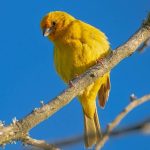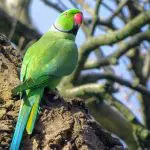Hawaii, a paradise of biodiversity, is home to a unique group of birds known as the honeycreepers. Over 50 species of honeycreepers once existed, but today, fewer than 20 remain due to habitat loss, introduced predators, and diseases like avian malaria. Each species is a marvel of evolution, showcasing a range of vibrant colors and diverse beak shapes. In this article we will look at 11 species of honeycreepers in Hawaii.
11 Honeycreepers in Hawaii
Honeycreepers, part of the finch family, are a prime example of “adaptive radiation”. In this phenomenon a single ancestral species evolves into a variety of new forms to fit different ecological niches. We know today that honeycreepers evolved to take advantage of the many nectar producing flowers on the islands. In fact, there are no hummingbirds in Hawaii, and honeycreepers help to fill their role as pollinators.
1. Scarlet Honeycreeper (‘I’iwi)
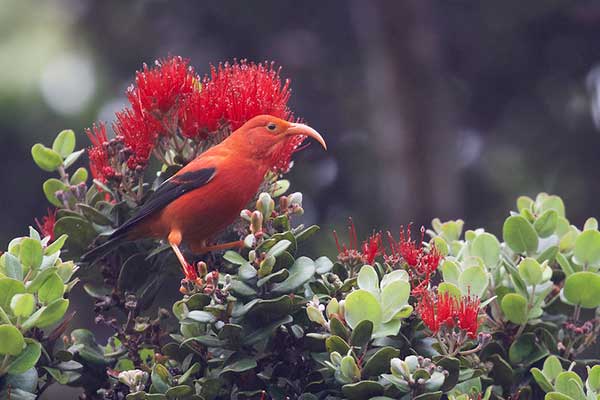
- Scientific name: Drepanis coccinea
- Islands found: Big Island, Maui, Kaua’i and small amounts on O’ahu and Moloka’i
The ‘I’iwi is a striking bird, known for its vibrant scarlet feathers and long, curved beak. It’s one of the most recognizable honeycreepers and a symbol of Hawaii. This species is typically found in high-elevation wet forests, particularly those with ‘ōhi’a trees, which provide a major source of nectar. Despite facing numerous threats, the ‘I’iwi remains one of the most common and widespread Hawaiian honeycreepers.
The ‘I’iwi’s curved beak is perfectly adapted for feeding on nectar from tubular flowers. It’s also known for its melodious song, which was once used in ancient Hawaiian chants and hula. Today, the ‘I’iwi continues to play a crucial role in the ecosystem as a pollinator, helping to maintain the health of Hawaii’s native forests.
2. Kaua’i Creeper (‘Akikiki)

- Scientific name: Oreomystis bairdi
- Islands found: Kaua’i (Alaka‘i Wilderness Preserve)
The ‘Akikiki, also known as the Kaua’i Creeper, is a small bird with a white belly and gray back. It’s known for its distinctive creeping behavior as it forages for insects on tree branches. This species is critically endangered due to habitat loss, introduced predators, and diseases like avian malaria.
The ‘Akikiki’s diet primarily consists of insects and their larvae, which it extracts from the bark of trees using its fine-pointed beak. Despite its small size, the ‘Akikiki plays a significant role in controlling insect populations in its native habitat. Conservation efforts are currently underway to protect this unique species and its forest home.
3. ‘Akeke‘e
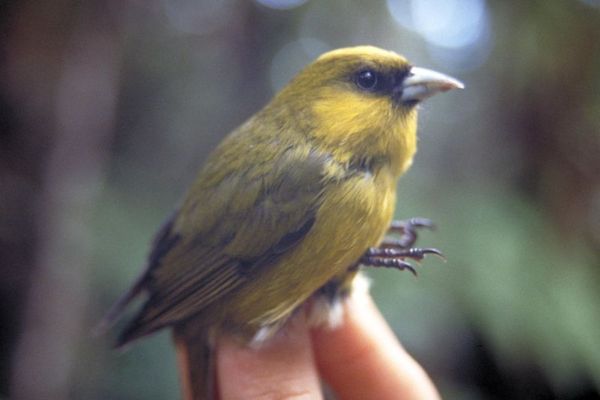
- Scientific name: Loxops caeruleirostris
- Islands found: Kaua’i
The ‘Akeke’e is a small greenish-yellow bird with a pale bill and black mask. While hard to see, these honeycreepers have an asymmetrical bill, which is bent to one side.
This adaptation allows it to extract spiders, caterpillars, and other arthropods from buds and bark of the ‘ōhi‘a plant. In fact, they are such specialists that they are rarely seen foraging on any other type of tree! Its distinctive call, a soft whistle or warble, adds to the rich soundscape of Kaua’i’s forests.
This species is critically endangered due to habitat loss, introduced predators, and diseases like avian malaria.
4. Maui Parrotbill (Kiwikiu)
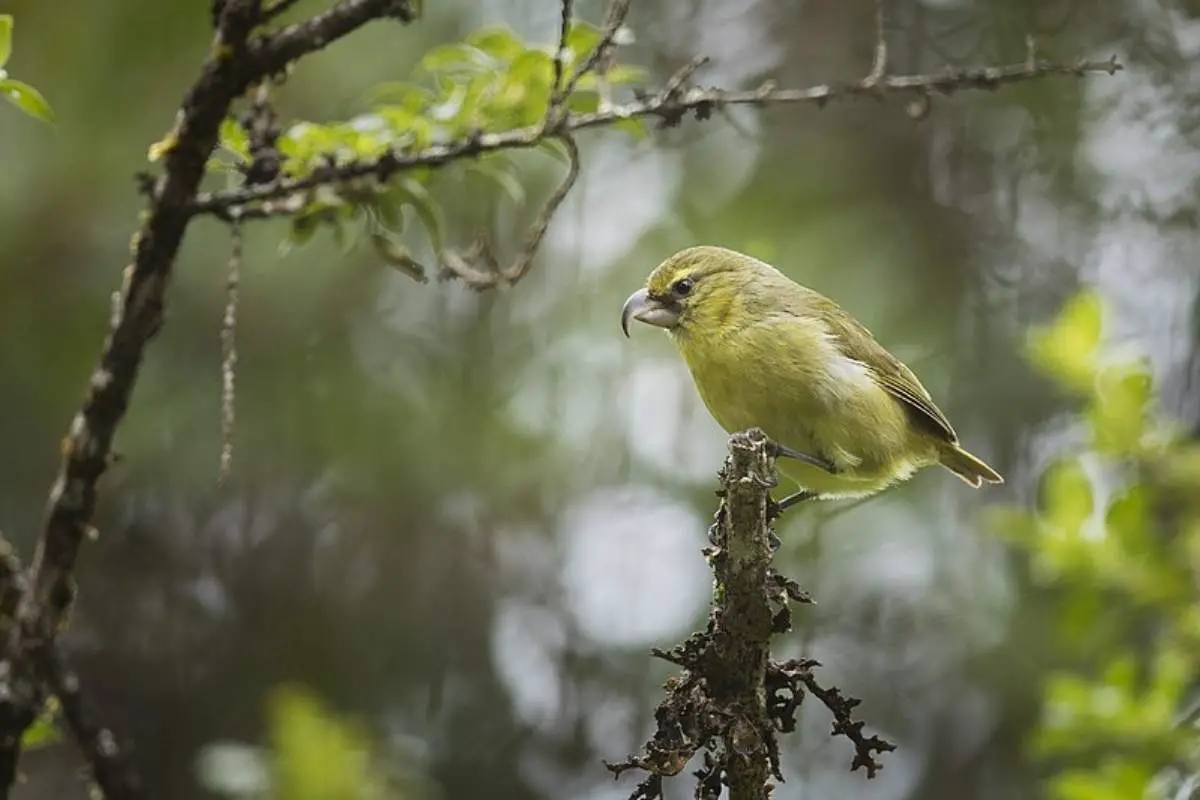
- Scientific name: Pseudonestor xanthophrys
- Islands found: Maui
The Kiwikiu, also known as the Maui Parrotbill, is a small bird with a large, parrot-like bill, which it uses to forage for insects in the bark of trees. It has a yellow chest and head, with olive-green wings and back. This bird is known for its strong bill, which it uses to strip bark from trees and extract insect larvae, earning it the nickname “Maui’s Woodpecker.”
The Kiwikiu is critically endangered, with fewer than 500 individuals estimated to be left in the wild. It is found in high-elevation wet forests on the slopes of Haleakalā, a volcano on Maui. Its preferred habitat is ‘ōhi’a and koa forests above 1,300 meters (4,300 feet) in elevation. Conservation efforts for the Kiwikiu include habitat restoration, the control of predators and invasive species, and captive breeding and release programs.
5. ‘Ākohekohe
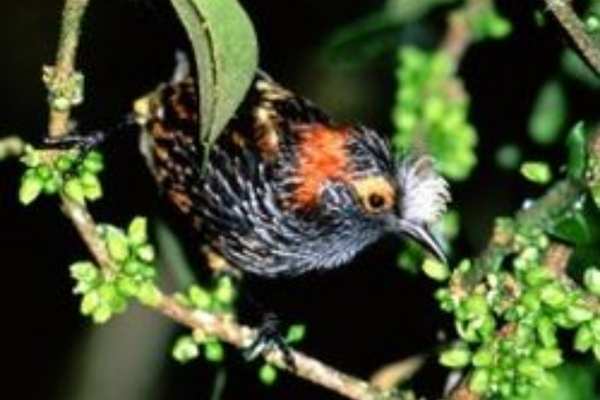
- Scientific name: Palmeria dolei
- Islands found: Maui
The ‘Ākohekohe, also known as the Crested Honeycreeper, is a distinctive bird with a crest of long, white-tipped feathers on its head. It has a black body with white and yellow markings. This species is found in high-elevation wet forests on Maui, particularly in areas with ‘ōhi’a trees.
The ‘Ākohekohe is known for its bold behavior, often dominating over other bird species at shared food sources. It feeds primarily on nectar but will also eat insects and fruit. Despite its boldness, the ‘Ākohekohe is critically endangered, primarily due to habitat loss and avian diseases brought to the islands by mosquitoes.
6. ‘Apapane
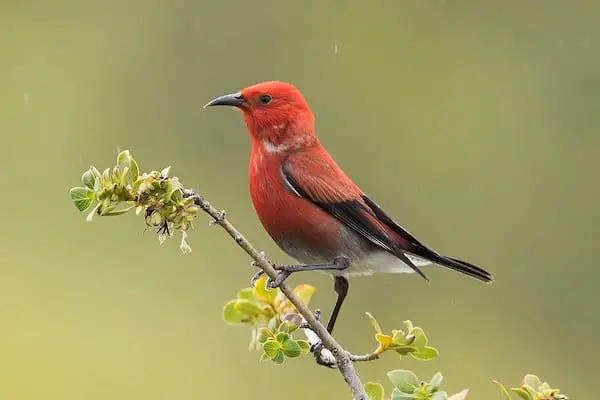
- Scientific name: Himatione sanguinea
- Islands found: All main Hawaiian Islands
The ‘Apapane is a medium-sized honeycreeper known for its bright red plumage and black wings and tail. It’s one of the most widespread and adaptable of the Hawaiian honeycreepers, found on all the main Hawaiian Islands.
The ‘Apapane is a highly mobile species, often moving between different elevations and islands in search of flowering ‘ōhi’a trees, its primary food source. Mainly nectar-eating birds, they also consume insects and spiders. Its beautiful song and aerial displays are a common sight in the Hawaiian forests. Despite facing many of the same threats as other honeycreepers, the ‘Apapane’s adaptability has allowed it to remain relatively common.
7. ‘Amakihi
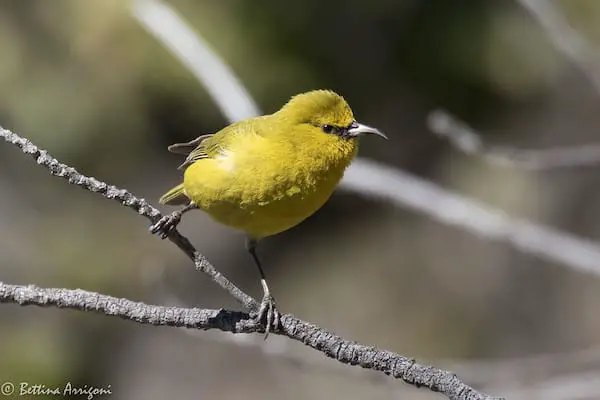
- Scientific name: Chlorodrepanis virens
- Islands found: Big Island, Maui, Moloka’i
The ‘Amakihi is a small, greenish-yellow bird with a thin, curved beak. It’s one of the most resilient of the Hawaiian honeycreepers, with populations on several islands.
‘Amakihis have a tubular tongues they use to feed on nectar from flowers. They also consume insects, small invertebrates and can suck the juice from fruit. Known for their ability to survive in a wide range of habitats, from sea level to high mountain forests. This adaptability has helped the ‘Amakihi persist in areas where other honeycreeper species have declined.
8. ‘Akepa
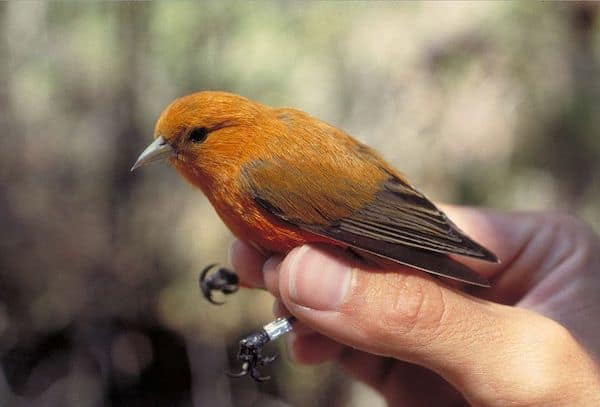
- Scientific name: Loxops coccineus (Hawai’i ‘Akepa)
- Islands found: Big Island
Most, if not all, of the living ‘Akepa today are the Hawai’i ‘akepa found on the Big Island. Maui ‘akepa may still exist today although are quite rare, and the O’ahu ‘akepa went extinct sometime around the 1930’s.
The ‘Akepa is a small bird with a unique, slightly crossed bill, and one leg shorter than the other. The side of the body with the short leg corresponds with the offset in their beak, giving them a slight advantage while grasping vegetation and foraging. Insects are hunted on ‘ohi’a leaf clusters and koa leaf buds and seed pods.
The ‘Akepa is known for its bright orange-red color in males and a greenish-yellow color in females. It’s typically found in high-elevation ‘ōhi’a forests. The ‘Akepa is considered endangered due to habitat loss, introduced predators, and diseases like avian malaria. Conservation efforts are underway to protect and recover these species.
9. ‘Akiapola’au
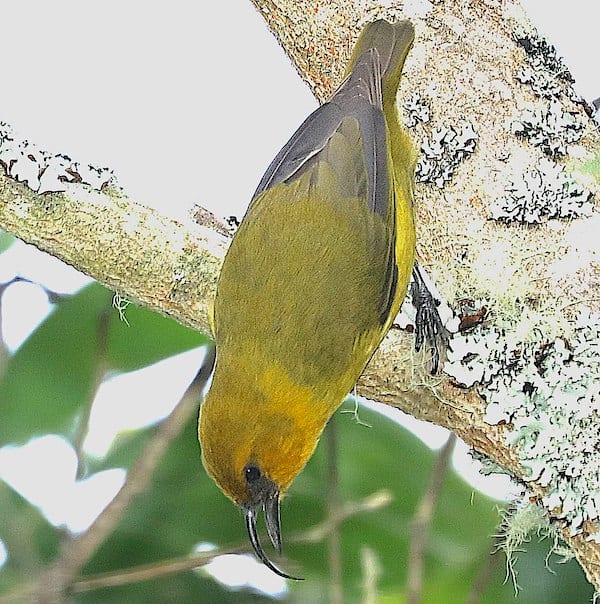
- Scientific name: Hemignathus munroi
- Islands found: Big Island
The ‘Akiapola’au is a small bird with a very unique looking beak. The upper mandible of the beak is long and curved, while the lower mandible is shorter and straight. This adaptation allows the bird to drill holes with the lower beak and extract insects with the upper beak, using the long curve to dig them out. The bird has a yellow chest and head, with a black mask around the eyes. Males are larger than females, and have longer beaks.
The ‘Akiapola’au is found in high-elevation forests on the Big Island, particularly in areas with large koa trees. It’s considered endangered, with a population of fewer than 1,000 individuals estimated. Conservation efforts for the ‘Akiapola’au include habitat restoration, the control of predators and invasive species, and research to better understand its ecology and needs.
10. ‘Anianiau
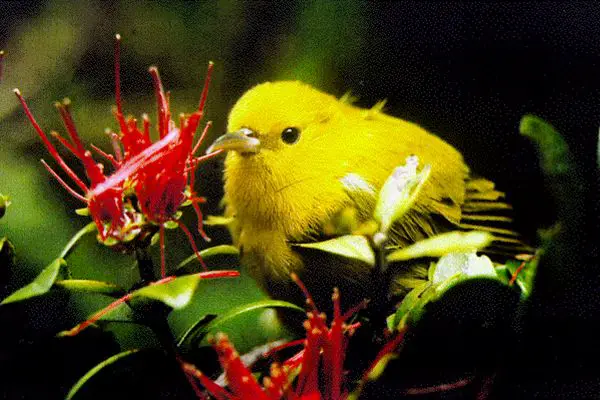
- Scientific name: Magumma parva
- Islands found: Kaua’i
The ‘Anianiau is a small bird, about 4 inches long, with a yellow-green color. They are the smallest of all the living honeycreepers in Hawaii. It has a short, curved beak that it uses to feed on nectar from several plants. The ‘Anianiau is considered vulnerable due to habitat loss, introduced predators, and diseases like avian malaria. Its population has been declining, but it was still relatively common compared to other Hawaiian honeycreepers.
The ‘Anianiau primarily feeds on nectar from native plants, but it also eats insects. It plays an important role in the ecosystem as a pollinator. Conservation efforts for the ‘Anianiau include habitat restoration, the control of predators and invasive species, and research to better understand its ecology and needs.
11. Palila
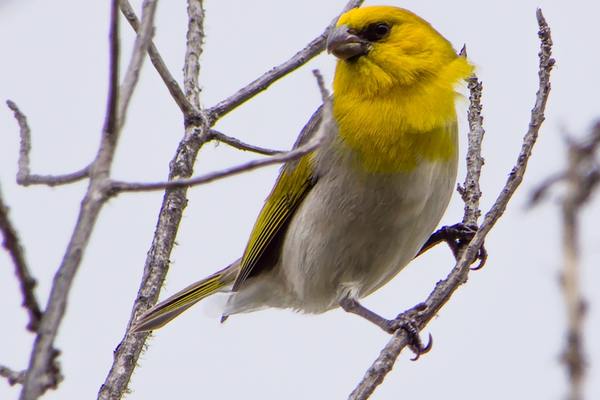
- Scientific name: Loxioides bailleui
- Islands found: Big Island
The Palila is a large honeycreeper, about 6-7 inches long, with a strong, finch-like beak. It has a yellow head and breast, a grey back, and white belly. The Palila is found in dry, high-elevation forests on the slopes of Mauna Kea, a volcano on the Big Island. Its preferred habitat is mamane-naio forests above 2,000 meters (6,500 feet) in elevation.
The Palila has a unique diet among honeycreepers, primarily feeding on the seeds, flowers, and immature green pods of the mamane tree. It also eats insects and caterpillars. The Palila is critically endangered, with a population of fewer than 2,000 individuals estimated. Conservation efforts for the Palila include habitat restoration, the control of predators and invasive species, and captive breeding and release programs.
The History of Honeycreepers in Hawaii
Hawaiian honeycreepers are a group of birds that are believed to have evolved from a single ancestral species that arrived in the Hawaiian Islands millions of years ago. This ancestral species, likely a type of finch, found itself in a land with diverse habitats and few competitors.
Over time, it evolved into more than 50 distinct species, each adapted to a specific ecological niche. This process, known as adaptive radiation, is a striking example of evolution in action.
The honeycreepers developed a wide range of beak shapes and sizes to exploit different food sources, from nectar to seeds to insects. They also displayed a dazzling array of colors, from the scarlet ‘I’iwi to the olive-green ‘Amakihi.
Unfortunately, the arrival of humans and the changes they brought to the islands have had a devastating impact on the honeycreepers. Habitat loss, introduced predators, and diseases like avian malaria have caused the extinction of many species and left others critically endangered.
Honeycreeper Conservation in Hawaii
Conservation efforts for the Hawaiian honeycreepers are being undertaken by a variety of organizations, including the U.S. Fish and Wildlife Service, the Hawaii Department of Land and Natural Resources, and non-profit groups like the American Bird Conservancy and the Maui Forest Bird Recovery Project.
These efforts include habitat restoration, the control of predators and invasive species, and captive breeding and release programs. For example, the ‘Alalā, or Hawaiian Crow, has been successfully bred in captivity and reintroduced into its native habitat. Other species, like the Maui Parrotbill and the Palila, have designated critical habitats protected by law.
Despite these efforts, many challenges remain. The spread of avian diseases, particularly avian malaria, is a major threat that is difficult to control. Climate change is also a concern, as it may alter the habitats that these birds depend on.
How to Spot a Honeycreeper in Hawaii
Spotting a Hawaiian honeycreeper can be a thrilling experience for any birdwatcher. Here are some tips to increase your chances:
- Visit the right habitat: Honeycreepers are typically found in high-elevation wet forests, particularly those with ‘ōhi’a and koa trees. The Hakalau Forest National Wildlife Refuge on the Big Island is a particularly good spot.
- Go at the right time: Early morning is often the best time for birdwatching, as many birds are most active during this time.
- Be patient and quiet: Honeycreepers can be shy and elusive. Sit quietly and wait for the birds to come to you.
- Look for movement: Honeycreepers are often on the move, foraging for food in the trees. Look for movement among the leaves and branches.
- Listen for their songs: Many honeycreepers have distinctive songs. Learning these songs can help you identify the birds even if you can’t see them.
Remember, while it’s exciting to spot these beautiful birds, it’s important to respect their space and not disturb them or their habitat. Look for tour groups that advertise bird watching. Local guides will know the best spots to see a variety of native birds. Happy birdwatching!

